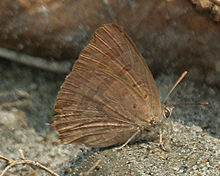centaurus group (subgenus Nilasera if valid) - Arhopala acron
- Arhopala adherbal Grose-Smith, 1902
- Arhopala admete (Hewitson, 1863)
- Arhopala aexone (Hewitson, [1863])
- Arhopala alkisthenes Fruhstorfer, 1914
- Arhopala amantes – large oakblue
- Arhopala ander
- Arhopala araxes C. & R.Felder, [1865]
- Arhopala azenia
- Arhopala centaurus – centaur oakblue, dull oakblue
- Arhopala eucolpis
- Arhopala eurisus
- Arhopala kirwinii Bethune-Baker, 1903
- Arhopala leander (Evans, 1957)
- Arhopala madytus – bright oakblue
- Arhopala meander Boisduval, 1832
- Arhopala micale
- Arhopala philander C. & R.Felder, [1865]
- Arhopala sophrosyne
- Arhopala styx
- Arhopala wanda
agesias group anthelus group (subgenus Narathura if valid) camdeo group - camdeo subgroup
- Arhopala anarte (Hewitson, 1862)– magnificent oakblue
- Arhopala belphoebe Doherty, 1889
- Arhopala camdana Corbet, 1941
- Arhopala camdeo (Moore, [1858])– lilac oakblue
- Arhopala dispar Riley & Godfrey, 1921
- Arhopala hayashihisakazui Seki & Treadaway, 2013
- Arhopala hellada Fruhstorfer, 1914
- Arhopala johoreana Corbet, 1941
- Arhopala opalina – opal oakblue
- Arhopala semperi Bethune-Baker, 1896
- Arhopala varro Fruhstorfer, 1914
- myrzala subgroup
- Arhopala bazaloides – Tamil oakblue
- Arhopala myrzala (Hewitson, 1869)
- Arhopala myrzalina Corbet, 1941
oenea group epimuta group amphimuta group - amphimuta subgroup
- Arhopala alica (Evans, 1957)
- Arhopala amphimuta (C. & R.Felder, 1860)
- Arhopala avathina Corbet, 1941
- Arhopala baluensis Bethune-Baker, 1904
- Arhopala dajagaka Bethune-Baker, 1896
- Arhopala delta (Evans, 1957)
- Arhopala inornata (C. & R.Felder, 1860) (tentatively placed here)
- Arhopala kurzi (Distant, 1885)
- Arhopala major (Staudinger, 1889)
- Arhopala moolaiana (Moore, [1879])
- Arhopala norda (Evans, 1957)
- Arhopala sceva Bethune-Baker, 1903
- Arhopala stubbsi Eliot, 1962
- Arhopala zylda Corbet, 1941
- muta subgroup
- perimuta subgroup (subgenus Darasana if valid)
agesilaus group alitaeus group | agrata group cleander group - cleander subgroup
- alea subgroup
- Arhopala aenigma Eliot, 1972
- Arhopala agaba – purple-glazed oakblue
- Arhopala alea – rosy oakblue
- Arhopala aroa (Hewitson, [1863])
- Arhopala aurelia (Evans, [1925])
- Arhopala evansi Corbet, 1941
- Arhopala milleri Corbet, 1941
- Arhopala normani Eliot, 1972
- Arhopala phaenops C. & R.Felder, [1865] (including A. detrita)
- Arhopala phanda Corbet, 1941
- Arhopala ralanda Corbet, 1941
- Arhopala selta (Hewitson, 1869)
- Arhopala sublustris Bethune-Baker, 1904
- Arhopala vihara (C. & R. Felder, 1860) (tentatively placed here)
eumolphus group rama group agelastus group fulla group aurea group (subgenus Aurea if valid) ganesa group (subgenus Panchala if valid) abseus group thamyras group hercules group
|












